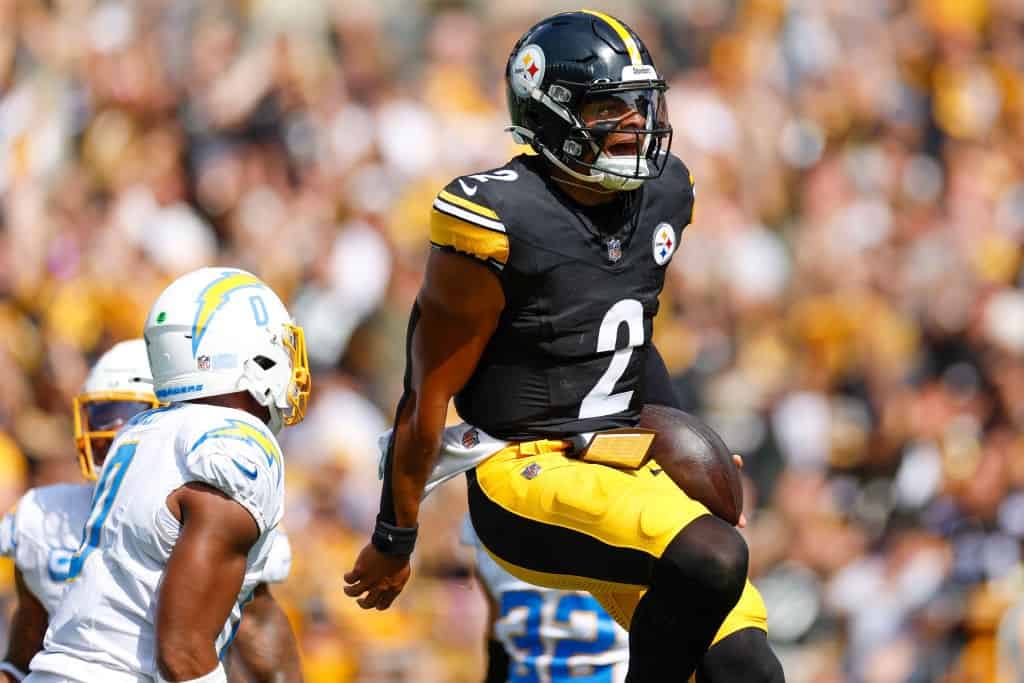The Steelers had a chance to set themselves up for success in a post Ben Roethlisberger era but willingly botched it worse than any team in modern NFL history.
They didn’t even try.
Now, they find themselves likely heading into the season with Justin Fields as their QB1 when he showed last year and throughout his career that he is not a QB1.
But before we analyze Fields and how he performed last year, let’s figure out how the Steelers put themselves into the position where, for two straight years, they are trotting out Fields as the Week 1 starter.
Pre Order The Best Analytical 2025 Football Preview
Don't miss out on Warren Sharp's 500+ page preview of the 2025 NFL season.
The preview is unlike anything you have ever seen, featuring stunning visualizations built with the reader in mind.
This preview shares insights into players, coaches, teams, and philosophies with one goal in mind: to get you prepared for the 2025 NFL season by delivering the smartest information in the fastest, most direct way possible.
Pre order the 2025 Football Preview now!
Steelers Quarterback Succession Plan
Following the 2016 NFL season, 34-year-old Roethlisberger first openly discussed the possibility of retiring.
The Steelers made it all the way to the AFC Championship game that year, ultimately losing to the New England Patriots. Roethlisberger did not retire, but he hinted at it.
After not having drafted a quarterback since 2013 (Landry Jones in Round 4), the Steelers decided that next draft (2017) to take another fourth-round QB (Joshua Dobbs).
The odds of a fourth-round QB working out and becoming a franchise QB are obviously exceedingly low, but the Steelers wanted to make it look like they were finding a replacement for Big Ben, something Roethlisberger didn’t exactly appreciate once he decided he wouldn’t retire and instead play in 2017.
Following the 2017 NFL season, 35-year-old Roethlisberger again discussed the possibility of retiring, saying he was taking things “one year at a time.”
That season, the Steelers went 13-3 and were the No. 2 seed in the AFC playoffs, landing a first round bye, but lost 45-42 in a crazy Divisional Round game against the Jaguars.
The Steelers again dabbled in the rookie QB market, selecting Mason Rudolph in Round 3 of the 2018 draft.
To be clear, neither Dobbs nor Rudolph were viewed as franchise caliber QBs, which is why they lasted until the third and fourth rounds of the draft.
If Roethlisberger decided to up and retire after either season, the Steelers would not be in any kind of position to compete with the quarterbacks on their roster.
The 2017 Steelers depth chart after Roethlisberger was QB2 Landry Jones and QB3 Joshua Dobbs.
The 2018 Steelers depth chart after Roethlisberger was QB2 Joshua Dobbs and QB3 Mason Rudolph.
The Steelers weren’t drafting a true franchise QB replacement. They were drafting for depth with hope one of these guys might surprise should Roethlisberger retire.
Then came the 2018 season, where the Steelers went 9-6-1 and missed the playoffs.
Roethlisberger turned 36 and agreed to a two-year contract extension after the season.
In the 2019 draft, the Steelers didn’t draft a quarterback and declined to address the future of the position.
Just two weeks into that 2019 season, 37-year-old Roethlisberger suffered a season-ending elbow injury. Pittsburgh finished 8-8.
It was following their Week 2 game that the Steelers made a wild decision.
One day after Roethlisberger suffered the season-ending elbow injury, sitting at 0-2 and surely set up for a better 2020 draft pick than what they had in years past, the Steelers traded their first-round draft pick (and a fifth and sixth-round draft pick) to the Miami Dolphins in exchange for safety Minkah Fitzpatrick, a fourth-round pick, and a seventh-round pick.
The Steelers, on the precipice of their highest first-round draft pick in years due to what was likely to be their worst record in years, trading away the pick and sticking with a 38-year-old QB was highly perplexing.
Particularly when you look at that 2020 QB draft class.
Along with 2018, this 2020 draft class might go down as the best in the last 20 years:
- Joe Burrow
- Justin Herbert
- Tua Tagovailoa
- Jordan Love
- Jalen Hurts
The 2020 class is arguably top-five of all time (along with 1983, 2004, and 2018).
And, in clear need of a quarterback for the future, the Steelers traded away their first-round pick.
That pick ended up being pick 18.
Even if the Steelers kept the pick and couldn’t trade up for one of the top-3 QBs, they could have drafted Love (pick 26) or Hurts (pick 53).
Instead, they chose to stick with 38-year-old Roethlisberger off a season-ending injury and to draft, at pick 49, WR Chase Claypool.
They took Claypool four spots ahead of Hurts.
Let me say that again.
Needing a QB to replace 38-year-old Roethlisberger off a season-ending injury, they took Chase Claypool four spots ahead of Jalen Hurts.
Roethlisberger returned for the 2020 season, but the Steelers’ season spiraled.
In their first trip to the playoffs since 2017, the Steelers lost at home in the Wild Card Round to the Cleveland Browns.
Long after the final whistle, Roethlisberger was pictured crying on the bench along with longtime center Maurkice Pouncey. It looked like he might walk away and not return for his 18th season at age 39.
Despite that, the Steelers STILL did not draft a quarterback in the 2021 NFL draft.
Roethlisberger returned for the 2021 season. Their depth chart behind Roethlisberger was QB2 Mason Rudolph and QB3 Dwayne Haskins.
They still had done nothing to set up a succession plan.
Roethlisberger finally retired following the 2021 season.
In the 2022 NFL draft, the Steelers finally drafted a successor, Kenny Pickett at No. 20 overall.
The bottom line?
Beginning in January of 2017, 34-year-old Ben Roethlisberger began discussing the possibility of retirement.
During the next five years, knowing Roethlisberger couldn’t possibly be around much longer, the Steelers did not spend a single pick in the top 75 on a quarterback.
Even though we saw two of the most talented QB draft classes in NFL history during these five seasons (2020, 2018).
And starting with the 2019 NFL draft and until Roethlisberger retired, the Steelers did not use a SINGLE pick to draft a quarterback.
Not in 2019. Not in 2020. Not in 2021.
It was an extremely negligent attempt by a team to establish a succession plan for when the long term QB retired.
In the six NFL drafts since 2018, the Steelers have drafted a total of one QB in the first six rounds (Pickett).
And that explains where the Steelers find themselves entering the 2025 NFL season.
Their starting QBs since 2022 have been:
- Kenny Pickett
- Mason Rudolph
- Mitchell Trubisky
- Justin Fields
- Russell Wilson
And as we enter the 2025 season, the Steelers have once again left themselves with poor quarterback options.
Russell Wilson vs. Justin Fields in 2024
Fields and Wilson both played on the cheap for the Steelers last year, and the Steelers have made it clear they are picking one of them to be their QB1 in the fall with the other one hitting free agency.
According to reports, the “winner” of the QB1 battle is likely to be Fields.
This will make the Steelers less likely to see success in 2025 because, between the two, Fields was decidedly worse than Wilson.
One of the most stable ways to evaluate a quarterback is early down performance from a clean pocket.
And in that metric last year, out of 43 qualifying quarterbacks, Wilson ranked:
#8 in EPA/attempt (+0.27)
#14 in success rate (54%)
#16 YPA (7.9)
#8 best TD:INT rate (6:1)
#10 fastest time-to-throw (2.3 seconds)
Fields ranked:
#36 in EPA/attempt (+0.04)
#34 in success rate (44%)
#28 in YPA (7.1)
#17 best TD:INT rate (3:1)
#43 fastest time-to-throw (2.7 seconds)
Among starting QBs, Fields was the second-worst next to what the Panthers were trotting out between Bryce Young and Andy Dalton.
Not only are most of the efficiency metrics at opposite ends of the spectrum, but the concerning part is Fields’ ability to operate the offense with his ridiculously high time-to-throw.
When he has time, instead of trying to operate the offense in rhythm, he holds the ball searching for something better, allowing good to be the enemy of great.
As a result, he winds up with not great, not good, but among the worst in the NFL.
And then there are the diametrically opposed QB boom and bust metrics.
When a QB generates more than 1 expected point added on a play, it is graded as a “boom” play, and when he generates worse than -1 expected point added on a play, it is graded as a “bust” play.
Wilson’s bust rate was #1 best in the NFL at 1%.
Fields' was #3 worst in the NFL, clocking in at #41 with 8%.
Additionally, Wilson ranked #12 in boom rate (23%) while Fields ranked #41 at only 13%.
Comparing boom to bust rate is absurd for these two.
Operating in the SAME EXACT offense, look at the boom/bust ratios.
- Wilson: #1 in the NFL (19:1 boom:bust)
- Fields: #43 in the NFL, worst of any QB (1.7:1 boom:bust)
On early downs when kept clean, Wilson delivered bigger plays without sacrificing bad plays.
Fields was the exact opposite. There was nothing big or explosive but he still had the NFL’s #1 highest rate of really bad bust plays.
While these numbers for Wilson were great, not all plays are early down passes from clean pockets, and Wilson’s problem was general panic and inability to perform when pressured on these early downs.
It’s rarely great to project future performance based on prior performance under pressure, but it’s been a recurring theme for Wilson.
Last year, when he was under pressure on early downs, he delivered (out of 43 QBs):
#38 EPA/attempt (-0.55)
#42 success (19%)
#41 YPA (4.5)
Fields was more industrious on these plays, but it must be noted his sample size includes just 18 completions.
Still, he was top 22 in EPA, success, and YPA when pressured on early downs.
Third downs saw mediocre performance from both quarterbacks in terms of being able to move the chains, but while Wilson converted at a higher rate, he made things harder on himself.
Wilson was a massive chucker on third downs.
He averaged 12.6 air yards per attempt (#2 highest) with 49% of attempts traveling beyond the sticks (#6 highest rate).
Despite that, he still completed these passes at a higher rate than Fields (59% for Wilson, 58% for Fields) with Fields averaging over 3 fewer air yards per pass attempt.
Wilson’s third down conversion rate was also slightly higher than Fields (35.1% vs 33.9%).
These conversion rates ranked #17 and #24 respectively out of 43 QBs.
But Wilson took pressure on 47% of his third down dropbacks (#7 highest rate) and held onto the ball for longer than Fields (2.9 seconds, #11 highest).
So Wilson took longer to throw and, as a result, welcomed more pressure and threw it much deeper, but somehow he still completed these passes at a higher rate and converted first downs slightly more frequently.
Moving beyond down-by-down analysis, I simply don’t know what the Steelers are going to get out of Fields.


















